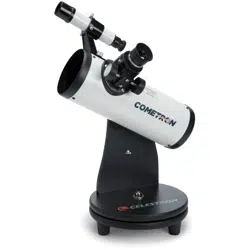Loading ...
Loading ...
Loading ...

With your telescope set up (and you have removed the front lens cap from the optical tube), you are ready to use it
for observing. This section covers visual observing hints for both solar system and deep sky objects as well as
general observing conditions which will affect your ability to observe.
O
O
b
b
s
s
e
e
r
r
v
v
i
i
n
n
g
g
t
t
h
h
e
e
M
M
o
o
o
o
n
n
Often, it is tempting to look at the Moon when it is full. At this time, the
face we see is fully illuminated and its light can be overpowering. In
addition, little or no contrast can be seen during this phase.
One of the best times to observe the Moon is during its partial phases
(around the time of first or third quarter). Long shadows reveal a great
amount of detail on the lunar surface. At low power you will be able to
the lunar disk. Change to the higher power eyepiece to focus in on a
smaller area.
L
L
u
u
n
n
a
a
r
r
O
O
b
b
s
s
e
e
r
r
v
v
i
i
n
n
g
g
H
H
i
i
n
n
t
t
s
s
To increase contrast and bring out detail on the lunar surface, use optional filters. A yellow filter works well at
improving contrast while a neutral density or polarizing filter will reduce overall surface brightness and glare.
O
O
b
b
s
s
e
e
r
r
v
v
i
i
n
n
g
g
t
t
h
h
e
e
P
P
l
l
a
a
n
n
e
e
t
t
s
s
Other fascinating targets include the naked eye planets. You can see Venus go
through its lunar-like phases. Mars can reveal a host of surface detail and one, if
not both, of its polar caps. You will be able to see the cloud belts of Jupiter and
the great Red Spot (if it is visible at the time you are observing). In addition,
you will also be able to see the moons of Jupiter as they orbit the giant planet.
Saturn, with its beautiful rings, is easily visible at moderate power
.
Planetary Observing Hints
y Remember that atmospheric conditions are usually the limiting factor on how much planetary detail will be
visible. So, avoid observing the planets when they are low on the horizon or when they are directly over a
source of radiating heat, such as a rooftop or chimney. See the "Seeing Conditions" section later in this section.
y To increase contrast and bring out detail on the planetary surface, try using Celestron eyepiece filters.
O
O
b
b
s
s
e
e
r
r
v
v
i
i
n
n
g
g
D
D
e
e
e
e
p
p
S
S
k
k
y
y
O
O
b
b
j
j
e
e
c
c
t
t
s
s
-
-
S
S
t
t
a
a
r
r
H
H
o
o
p
p
p
p
i
i
n
n
g
g
Deep-sky objects are simply those objects outside the boundaries of our solar system. They include star clusters,
planetary nebulae, diffuse nebulae, double stars and other galaxies outside our own Milky Way. Most deep-sky
objects have a large angular size. Therefore, low-to-moderate power is all you need to see them. Visually, they are
too faint to reveal any of the color seen in long exposure photographs or detailed structure like spiral arms of
galaxies, etc. which can only be seen with larger telescopes. Instead, they appear black and white and are fuzzy
patches. And, because of their low surface brightness, they should be observed from a dark-sky location. Light
pollution around large urban areas washes out most nebulae making them difficult, if not impossible, to observe.
Light Pollution Reduction filters help reduce the background sky brightness, thus increasing contrast.
As your interest in astronomy grows, you will probably navigate to larger aperture telescopes which will show much
more detail and enhance the quality of the views you will see.
10
Loading ...
Loading ...
Loading ...
